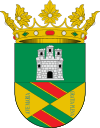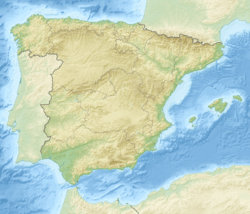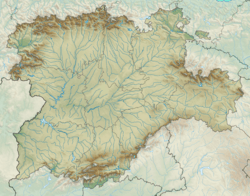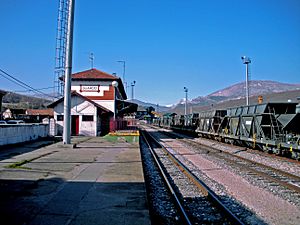Guardo facts for kids
Quick facts for kids
Guardo
|
||
|---|---|---|
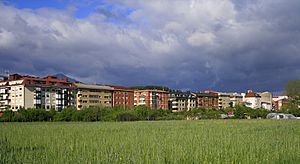 |
||
|
||
 |
||
| Country | ||
| Autonomous community | ||
| Province | ||
| Area | ||
| • Total | 62.83 km2 (24.26 sq mi) | |
| Elevation | 1,123 m (3,684 ft) | |
| Population | ||
| • Total | 6,153 | |
| • Density | 97.931/km2 (253.64/sq mi) | |
| Demonym(s) | guardense | |
| Postal code |
34880
|
|
Guardo is a town and municipality (a type of local government area) in northern Spain. It is located in the Montaña Palentina region. This area is part of the province of Palencia in the autonomous community of Castile and León. In 2023, about 5,653 people lived in Guardo. This makes it the third largest town in its province.
Contents
Guardo's History
Early Beginnings
We don't know much about Guardo's very early history. The name of one of its areas, Valdecastro, hints that there might have been an old Celtic fort. However, there are no records to prove this. The name "Guardo" itself has different ideas about where it came from. Some think it means "Mouth of the Heights," like a difficult mountain pass. Others believe it comes from a Celtic word meaning "Land of Storms."
Guardo was first mentioned in the 900s. It was called 'Buardo' or 'Boardo' back then. It was a village connected to a nearby monastery. Guardo had a castle on a hill above the Carrión river. This castle was important for watching out for possible attacks. It also helped control the border with the Kingdom of León and the County of Castile.
In the 1200s, King Alfonso VII ordered the castle to be kept strong. It had a tower to watch travelers, a chapel, and a burial ground. By the 1800s, the castle was gone. Its stones were used to build a train line.
From 1636 to 1801, Guardo was part of the province of Toro. After that, it joined Palencia, where it still is today. For a long time, Guardo was a small farming village. People mostly raised cattle and grew crops.
Growth and Change
Guardo started to grow a lot when coal was found nearby in the late 1800s. A new train line was built to carry this coal to ports and factories. As mining began in the early 1900s, many people moved to Guardo for work. The town changed a lot. New houses were built around the old center. The population grew steadily. It reached its highest point in the 1960s. At that time, it had more than double the people it has today.
During the 1930s, Guardo was a place where workers often protested. This was because of the difficult conditions in the mines. After this period, the region became more peaceful.
By the 1980s, coal mining started to decline. This was due to new economic rules and environmental goals. The whole region faced tough economic times. Many services, like hospitals, were lacking. People also started moving away from the area. This problem of people leaving rural areas still affects much of Spain today.
Guardo's Location and Landscape
Guardo is located next to the Carrión river. It sits on the southern side of the Sierra del Brezo mountains. These mountains separate the Cantabrian Mountains from the Meseta Central (a large plateau in Spain).
The town is about 1,123 meters (3,684 feet) above sea level. Most of Guardo is quite modern. It was built mainly in the first half of the 1900s. There is a small older part of town on a hill to the east. The main part of town is on the left side of the river. The right side has the railway and old factory buildings. Many of these are no longer used.
The municipality of Guardo includes the main town. It also has three smaller villages: Muñeca, Intorcisa, and San Pedro de Cansoles.
Guardo is 91 km (56 miles) from Palencia, the capital city of its province. It is also 145 km (90 miles) from Valladolid and 85 km (53 miles) from León.
It is the main town of the Alto Carrión area. It is by far the largest settlement in this mountainous part of northern Castille and Leon.
The highest point in the municipality is Peña Mayor de Guardo, at 1,836 meters (6,023 feet). The lowest point is around 1,100 meters (3,600 feet) by the Carrión river.
Guardo is on the Camino Olvidado a Santiago. This means the 'Forgotten Way' of St James. It is an old route of the Camino de Santiago. This path was used by some of the first pilgrims traveling to Santiago de Compostela in Galicia.
Guardo's Climate
Guardo has a fresh Mediterranean climate. This means it has warm, dry summers and cool, wet winters. Sometimes, it can feel a bit like an oceanic climate. The table below shows the average weather in Guardo:
| Climate data for Guardo en el periodo 1962-2019 | |||||||||||||
|---|---|---|---|---|---|---|---|---|---|---|---|---|---|
| Month | Jan | Feb | Mar | Apr | May | Jun | Jul | Aug | Sep | Oct | Nov | Dec | Year |
| Mean daily maximum °C (°F) | 7 (45) |
9 (48) |
14 (57) |
17 (63) |
22 (72) |
27 (81) |
30 (86) |
30 (86) |
26 (79) |
19 (66) |
14 (57) |
8 (46) |
19 (66) |
| Daily mean °C (°F) | 1.5 (34.7) |
4 (39) |
7 (45) |
12.5 (54.5) |
15.5 (59.9) |
20.5 (68.9) |
24 (75) |
23.5 (74.3) |
18 (64) |
13.5 (56.3) |
7 (45) |
2.5 (36.5) |
9.5 (49.1) |
| Mean daily minimum °C (°F) | −2 (28) |
0 (32) |
4 (39) |
6 (43) |
12 (54) |
12 (54) |
14 (57) |
14 (57) |
12 (54) |
8 (46) |
2 (36) |
−2 (28) |
7 (44) |
| Average precipitation cm (inches) | 24.5 (9.6) |
20.6 (8.1) |
13.1 (5.2) |
3.6 (1.4) |
0.2 (0.1) |
0 (0) |
0 (0) |
0 (0) |
0 (0) |
0 (0) |
4.7 (1.9) |
5.6 (2.2) |
72.3 (28.5) |
| Average rainy days | 14 | 12 | 10 | 16 | 9 | 8 | 4 | 3 | 6 | 12 | 15 | 7 | 116 |
| Average snowy days | 7 | 8 | 6 | 3 | 1 | 0 | 0 | 0 | 0 | 0 | 2 | 3 | 30 |
| Source: Ministerio de Agricultura, Alimentación y Medio Ambiente. Datos de precipitación para el periodo 1961-2003 y de temperatura para el periodo 1971-1992 en Guardo. | |||||||||||||
Guardo's Culture
Festivals and Celebrations
Guardo has several fun festivals throughout the year:
- Week of June 13: San Antonio de Padua (the main town festival)
- June 24: San Juan
- July 10: Santa Marta
- July 16: Procession of El Carmen
- December 4: Santa Bárbara (the special day for miners)
Important Landmarks
St John the Baptist Church
This church is on a hill in the eastern part of town. It was built in the 1300s in a beautiful Gothic style. Inside, you can find an old Romanesque font from the 1700s.
Archbishop Bullón's Palace
This palace is in the upper part of town. It is famous for its amazing Baroque style front from the 1700s. It is considered a special cultural site and was fixed up in 2022.
Monument to the Miner
This monument is a 4-meter (13-foot) tall bronze statue. It shows different things related to coal mining. It stands on a concrete base with a pool and fountains. The monument was opened in July 1975. It was made by the artist Jacinto Higueras Cátedra. It honors the miners and is a very important symbol of the town. Many people in Guardo use it as a meeting spot.
Guardo Town Hall
In November 2018, Guardo opened its new town hall building. This was 11 years after the old one was taken down. The new building also has a police station and a large hall for events that can hold 400 people.
'Source of the Carrión' Park
This is a small park west of the town center. It is located along the Carrión river. The park is named after Fuentes Carrionas. This is a glacial lake that is the traditional source of the river.
Guardo's Economy
For a long time, the main way people earned money in Guardo was through coal mining. Mining started later here than in other parts of Spain. This was because the coal was deeper underground. It needed new technology to reach it.
In 1942, a large chemical factory was built in Guardo. It was owned by Unión Explosivos Río Tinto. This factory worked for over 40 years. Over time, many of its buildings were taken down. The factory finally closed in May 2008. Its last owner was an American company called Celanese.
Famous People from Guardo
- Ana José Cancio (born 1960): A journalist who worked for TVE and RNE (Spanish TV and radio).
- Francisco Díaz Santos Bullón (1687-1764): A priest and important leader. He was an Archbishop and a Governor.
- Jesús Landáburu (born 1955): A former football player. He played for teams like FC Barcelona and Atlético Madrid. He also played a short time for the Spanish national team.
- Claudio Prieto (1934-2015): A classical music composer. He was born in Muñeca, a village near Guardo. The main high school in Guardo was once named after him.
See also
 In Spanish: Guardo para niños
In Spanish: Guardo para niños


